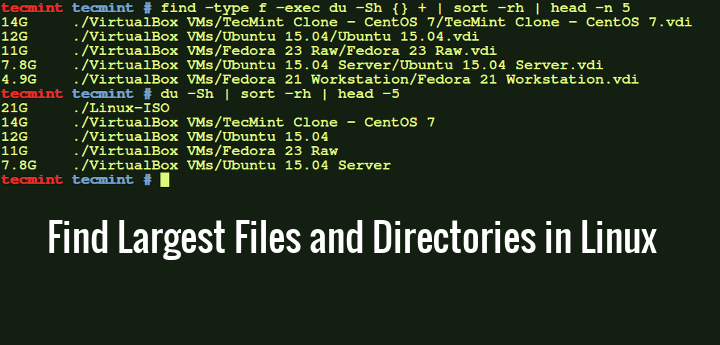How to Show Which Files Are Using Space Centos
Estimate file space usage. Head- Display first 10 files and output the first part of files.

How To Find Top Directories And Files Disk Space In Linux
By default tail command displays the last 10 lines of a file.

. Most of the time files are deleted manually but processes using those files keep them open and hence space is not reclaimed. Show activity on this post. Sort lines of text files or given input data.
To skip directories and only display files use the following command find pathtosearch -type f -printf s pn sort -nr head -10. Compare according to string numerical value-r. Df du and ncdu.
Or find pathtosearch -type f -iname mp4 -printf s pn sort -nr head -10 Hunt Down Disk Space Hogs with Ducks. Dir -a dir -A. How to use df command.
1 Login to WHM. Displays all files and folders. To sort these directories by size making it easy to identify which ones are consuming the most space we can pipe our du command to the sort utility.
Du- It estimates file space usage. Steps to find Largest directories in Linux. You can also pass multiple directories and files separated by space.
Use the following bash shell commands as shown below. Reverse the result of comparisons. Head and Tail commands can be combined to display selected lines from a file.
2 Select List Accounts which is under Account Information. Df displays the disk usage of whole file systems. Right after doing that it could be useful to repeat the gt5 or df -h command to see how much disk space weve recovered.
To resolve this issue you need to gracefully or forcefully end processes using those. This command displays each file name argument. Here well focus on doing it right and doing it simple by using three commonly available command line tools.
Find var -name log -size 50M -mtime 7 -o -mtime 30 -exec truncate --size 0. Output the first part of files-n. This returns amount of space used by a directory and its subdirectories up to 4 deep sort -n will put the largest last.
Du -c --max-depth4 dir sort -n. Your terminal may show the file name with space escaped with backslash if you press tab key for the filename. For example to list the contents of the etc directory you would type.
If youre using the -h option on du make sure you also use it on sort. Du -h --max-depth1 671M Arch Linux 17G Debian-based 415M Gentoo 27G RHEL-based 44G. Checking Disk Usage With df.
Estimate file space usage. Find Large Files Using the find Command The find command is one of the most powerful tools in the Linux system administrators arsenal. Df command displays the amount of free disk space which is available on file system.
However We can use following three commands with pipes to do this. Wrap the entire filename between quotes. Ncdu an ncurses tool for displaying and analysing file and directory sizes.
Usually Linux systems run out of disk space due to large log or backup files. I do a lot of data-intensive calculations with a large number of small files and a very small number of very large files. The du command list all the contents and files which their sizes.
Tab completion often works with spaces as well. Sort lines of text files-n. Print the first n lines.
To list files in a specific directory pass the directory path as an argument to the ls command. Follow the below steps to view the disk space usage for each of your cPanel accounts. 3 All your cPanel accounts will be listed and disk space usage can be viewed under DISK USED column.
Df is used to show usage at the filesystem level while du can be used to show how much space individual files and directories use. The command line program df is used to show. Output the first part of files ie.
This command is useful to track space hogs. Here we will learn how to remove deleted open files in Linux. While head command displays file from the beginning the tail command displays file from the end.
Escape every space using backslash key. Ls etc var etcpasswd. In our case We displayed the first 5 lines.
File name withn spaces. File name with spaces. This answer is not useful.
Df also shows incorrect space utilization. Du displays the disk space usage of files in a given path or the whole system. To show hidden files run the dir command with the -a or the -A option in order to exclude implied files and folders.
New versions of sort can handle human-readable sizes so one can use much more readable. Ill show it in detail. Since most of my disk space used is in a very small number of files it can be difficult to track down where these large files are.
Although there is no any shortcut command to find out the top space consuming directories and files on Linux system. This tutorial explains how to find the largest files and directories in Linux systems using the find and du commands. For example to show hidden files in your home directory you would run.
If you arent familiar with how Linux presents storage devices you will probably want to read the mounting section of. To display first 10 largest file. You can also use tail command to see the changes made to a file in real time.
Sort- Sort lines of text files or given input data. Deleting a 1 kB file does not free much space but deleting a 100 GB file does.

Check Disk Space Usage On Centos

0 Response to "How to Show Which Files Are Using Space Centos"
Post a Comment